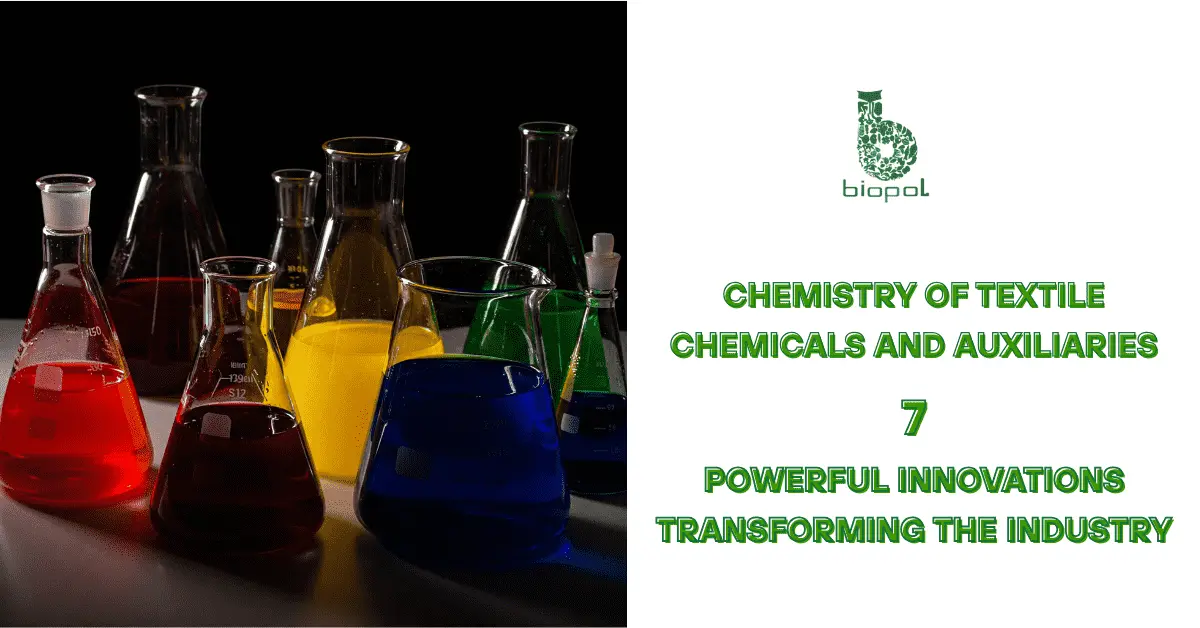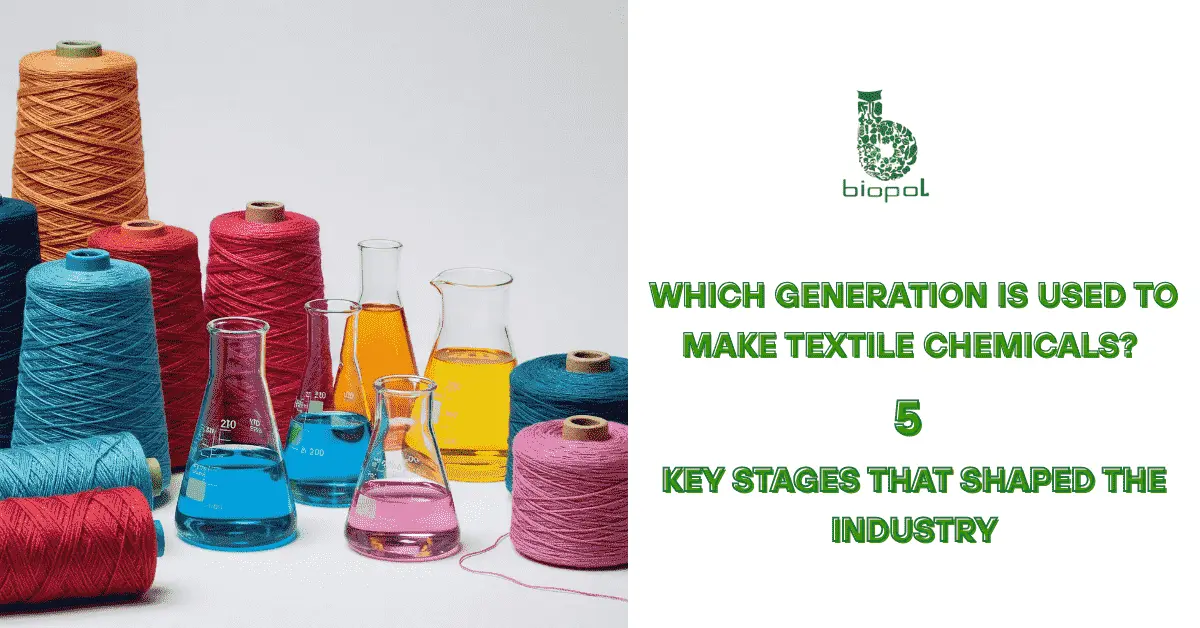
Chemistry of textile chemicals and auxiliaries drives fabric quality and sustainability. Understanding their molecular structure is key to optimizing performance, environmental impact, and innovation in textile treatment.
Table of Contents
Chemistry of Textile Chemicals and Auxiliaries
Textile chemicals and auxiliaries consist of molecules designed to interact specifically with fibers and dyes during fabric processing. Functional groups like hydroxyl, carboxyl, and amine govern their solubility, reactivity, and fiber affinity, essential for effective treatment. Molecular structure dictates key properties like solubility, reactivity, and fiber affinity, essential for treatment effectiveness. Textile auxiliaries fall into several types based on their molecular makeup:
- Surfactants: Amphiphilic molecules that improve wetting and cleaning.
- Softeners: Cationic or nonionic compounds enhancing fabric softness.
- Enzymes: Protein-based catalysts that modify fibers and remove impurities.
- Emulsifiers: Molecules that stabilize mixtures for uniform application.
Understanding these chemical foundations clarifies how auxiliaries function and sets the stage for selecting suitable chemicals in textile processing.
Classification of Textile Chemicals
Textile chemicals are categorized by their distinct industrial functions and chemical behavior during fabric processing. This classification guides the targeted use of auxiliaries to optimize textile treatment.
Key categories include:
- Surfactants: Enhance wetting, emulsification, and cleaning by reducing surface tension.
- Softeners: Improve fabric handle and drape through lubricating action.
- Enzymes: Catalyze specific reactions such as desizing and fiber modification with high selectivity.
- Emulsifiers: Maintain stable mixtures of immiscible substances for consistent application.
- Defoamers: Control foam formation during wet processing to prevent defects.
- Sequestering Agents: Bind metal ions to avoid interference in chemical reactions.
- pH Regulators: Adjust acidity or alkalinity to maintain optimal processing conditions.
- Carriers: Assist dye penetration, especially in synthetic fibers.
Each class exhibits unique chemical properties tailored to their function, ensuring efficiency and quality in textile manufacturing.
Role of Functional Groups
These compounds hinges on functional groups—those active parts of molecules that define their behavior in fabric treatments. They’re the chemical “hooks” that make everything work.
Why are functional groups essential in textile processing? Because they determine how chemicals bind, react, and perform under heat, pH, and mechanical stress.
Key Functional Groups and Their Textile Roles:
- Hydroxyl (-OH):
- Carboxyl (-COOH):
- Increases reactivity with fiber surfaces
- Used in dispersing agents and crosslinkers for better dye fixation
- Amine (-NH₂):
- Enables cationic charge and ionic bonding
- Critical in fixing agents and antistatic treatments
- Sulfonate (-SO₃H):
- Improves solubility and dye dispersion
- Common in leveling agents and anionic surfactants
- Ester (-COOR):
- Enhances hydrophobicity and flexibility
- Key in finishing agents for water repellency and wrinkle resistance
These groups aren’t just decorative side chains—they’re chemical workhorses that control everything from dye uptake to wash durability.
Chemical Mechanisms in Dyeing and Finishing
The chemistry of textile chemicals and auxiliaries controls how dyes and finishing agents interact with fibers at a molecular level, impacting colorfastness and surface performance.
Key chemical mechanisms include:
- Dye Fixation
- Involves ionic, covalent, or hydrogen bonding between dye molecules and fiber functional groups
- Ensures strong, durable coloration
- Leveling Agents
- Modify surface tension to allow even dye distribution
- Prevent blotching and streaks during dyeing
- Finishing Agents
- Chemically alter fiber surfaces through cross-linking or film formation
- Impart desirable properties like water repellency, wrinkle resistance, and softness
Mastering these interactions enables controlled, high-performance textile treatments.
Impact on Fiber Properties
The chemistry of textile chemicals and auxiliaries directly alters fiber characteristics by modifying surface and internal structures at the molecular level. These changes aren’t cosmetic—they redefine how textiles behave in real-world use.
Key chemical effects of auxiliaries include:
- Softness Enhancement
- Softeners coat or penetrate fibers with cationic or nonionic compounds
- Reduce friction, improving drape and hand feel
- Water Repellency
- Fluorochemicals or silicone-based agents form hydrophobic layers
- Prevent moisture penetration without compromising breathability
- Durability Boost
- Cross-linking agents create bonds within fiber matrices
- Strengthen resistance to washing, abrasion, and environmental stress
Each auxiliary works at the microscopic level to enhance macroscopic performance—making fabrics not just better, but longer-lasting.
Eco-Friendly Innovations
The chemistry of textile chemicals and auxiliaries is undergoing a sustainable transformation, driven by environmental mandates and consumer demand for cleaner production.
Key innovations in green textile chemistry include:
- Biodegradable Auxiliaries
- Derived from plant-based surfactants, enzymes, and polymers
- Break down naturally without harming water bodies or ecosystems
- Low-Impact Finishing Agents
- Silicone-free softeners and formaldehyde-free resins
- Reduce toxicity and energy use in curing and application
- Waterless and Solvent-Free Processes
- Supercritical CO₂ dyeing and plasma treatments
- Slash water consumption and chemical discharge
These advances show that high performance and environmental responsibility no longer have to be at odds—clean chemistry is setting the new benchmark.
Industrial Applications
The chemistry of textile chemicals and auxiliaries plays a decisive role in selecting the right agent for each stage of textile processing. Chemical properties—like pH compatibility, thermal stability, and reactivity—directly influence performance outcomes.
Application-wise, here’s how selection is guided:
- Scouring Agents
- Use alkaline surfactants to remove waxes, oils, and impurities
- Must maintain fiber integrity under high pH and temperature
- Bleaching Agents
- Oxidizing compounds like hydrogen peroxide break down natural pigments
- Require stabilizers and activators for controlled reactivity
- Printing Auxiliaries
- Thickeners, binders, and dispersing agents must ensure dye precision and fixability
- Viscosity and ionic charge are critical selection criteria
- Finishing Chemicals
- Selected for durability, softness, or functionality (e.g., water repellency)
- Must form lasting bonds without degrading fiber structure
Precision in chemical choice isn’t optional—it’s the backbone of efficient, consistent textile production.
Quality Control and Testing
The chemistry of textile chemicals and auxiliaries must meet rigorous quality benchmarks to guarantee performance, safety, and consistency in manufacturing.
Effective quality control includes:
- Chemical Purity Testing
- Ensures raw materials meet composition standards
- Common methods: titration, chromatography, spectroscopy
- Stability Analysis
- Evaluates shelf life under varied temperature, light, and pH conditions
- Prevents degradation during storage or application
- Performance Testing
- Assesses functionality such as dispersibility, wetting, and reactivity
- Simulates real textile process conditions to predict field behavior
- Batch-to-Batch Consistency
- Maintained through in-process checks and statistical sampling
- Vital for repeatable results across production cycles
Without strong testing protocols, even a well-designed chemical can fall short on the factory floor.
Regulatory and Safety Considerations
The chemistry of textile chemicals and auxiliaries is tightly regulated to protect workers, consumers, and the environment. Safety and compliance are not afterthoughts—they’re integral to responsible chemical usage.
Key considerations include:
- Regulatory Compliance
- Adherence to global frameworks like REACH (EU), TSCA (US), and BIS (India)
- Restrictions on hazardous substances such as azo dyes, formaldehyde, and heavy metals
- Safe Handling Practices
- Mandatory use of PPE (gloves, goggles, ventilation)
- Clear labeling, storage guidelines, and Material Safety Data Sheets (MSDS)
- Environmental Impact Controls
- Monitoring effluent discharge and adopting zero-liquid discharge (ZLD) systems
- Transitioning to biodegradable and non-toxic alternatives wherever possible
Ignoring safety is costly. Compliance minimizes risk, avoids penalties, and builds trust across the supply chain.
Future Trends in Chemical Technologies
The chemistry of textile chemicals and auxiliaries is entering a new frontier—where innovation is not optional but inevitable. From nano-chemicals to responsive formulations, tomorrow’s textiles begin in the lab.
Emerging trends to watch:
- Nano-Enabled Auxiliaries
- Nanoparticles offer antimicrobial, UV-protective, and self-cleaning properties
- Engineered for deep fiber penetration and long-lasting functionality
- Smart Chemical Systems
- Auxiliaries that react to temperature, pH, or moisture levels
- Enable adaptive fabrics for sportswear, medical use, and protective gear
- Bio-Based and Enzyme-Driven Chemistry
- Enzymatic scouring and bleaching reduce energy and chemical loads
- Biosurfactants and polymers sourced from renewable feedstocks
- Digitally Optimized Formulations
- AI-assisted blending ensures precision in chemical dosing and performance tracking
- Reduces waste and enhances reproducibility
What’s coming isn’t just improvement—it’s transformation rooted in scientific advancement and sustainability.
Faqs
What is the chemistry of textile chemicals and auxiliaries?
It involves the study of molecular structures and reactions that enable chemicals to modify fabrics during processing.
How do auxiliaries work in textile chemistry?
Auxiliaries interact chemically with fibers and dyes to improve properties like softness, color fastness, and durability.
Which functional groups are important in textile chemicals?
Hydroxyl, carboxyl, and amine groups play key roles in reactivity and fiber affinity.
Why is understanding textile chemical composition important?
Knowing composition helps select the right chemicals for efficient, high-quality fabric treatment.
Are textile auxiliaries environmentally safe?
Many modern auxiliaries are designed to be biodegradable and eco-friendly, aligning with sustainable textile processing goals.

